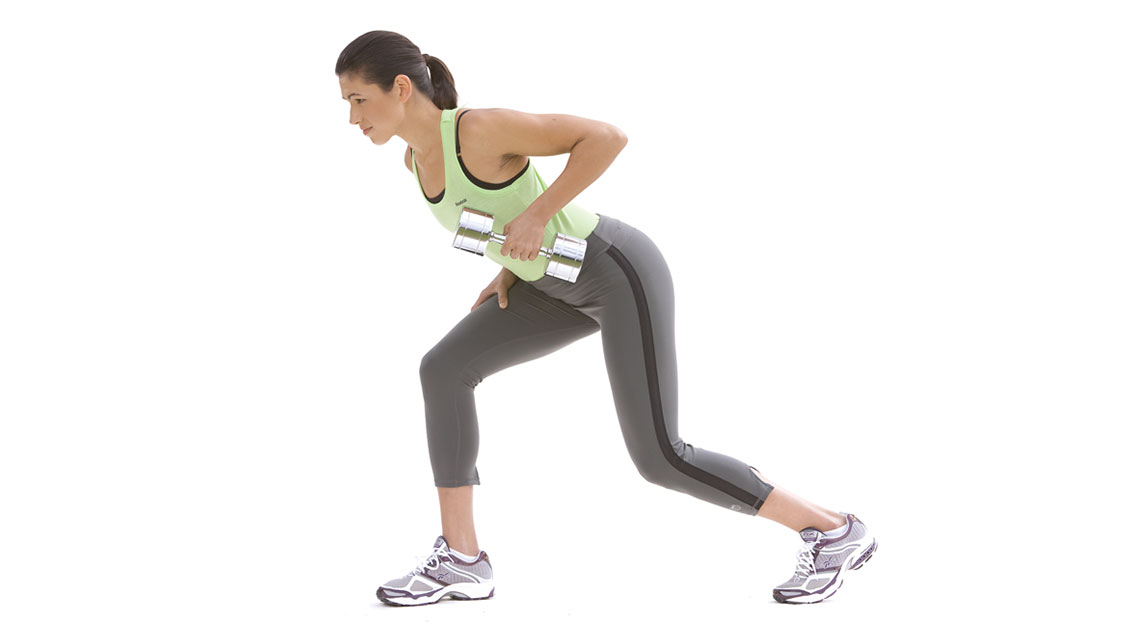Q1: 10-Minute Fitness
I’m interested in getting in better shape, but I’m too busy to change very much right now. What can I do if I can commit to only 10 minutes a day?
A: Congratulations on making a daily commitment to improving your fitness. Some of the best workouts take less than 10 minutes, so if you’re willing to make a focused, consistent effort, you can still enact some pretty substantial changes. That said, your body will adapt to even the most challenging workout if you do the same thing every day, so I asked Michael Y. Seril, MS, founder of the Excellence through Exercise Foundation, how to make the most of your minutes. His recommendation: Use as many muscles as possible in every exercise, move constantly, and challenge both your muscular and cardiovascular systems with as much intensity as you can muster. Here’s how.
Choose three exercises: two full-body movements (we’ll get to examples in a sec) and one type of cardio movement. Perform each exercise for 30 seconds, then do active rest (such as walking around the room) for 30 seconds after you’re finished with all three. Repeat the cycle a second time, then choose another combination of exercises and complete two cycles of that.
For example, the first combo might consist of burpees, plank holds and jumping jacks, followed by mountain climbers, side plank holds and running in place. Total workout time: eight minutes. (See more suggestions in “Workday Workouts.”)
Additionally, consider adjusting your daily regimen in little ways that don’t demand much time but that will significantly support your health-and-fitness efforts. For instance, start each day with a big glass of water, and take 30 seconds each morning to pack a stash of veggies and hummus or a bag of almonds you can bring to work for an energy-sustaining snack. Whenever you take the stairs, take them two at a time, or at a run. Once you start making fitness a small, nonnegotiable part of your day, I predict that you’ll find a way to make it a bigger one.
(Also try this 20-minute kettlebell workout and these fitness stacks.)
Q2: Teens and Creatine
My 16-year-old son is trying to build muscle, and he uses a creatine supplement. I’ve heard conflicting opinions about how safe it is and how old you should be when you start taking it. Can you provide your thoughts?
A: Every few years, creatine gets vilified in the press for one reason or another — often involving misunderstandings about dehydration, cramping and muscle injury, and often involving athletes training in unsafe conditions. But the fact remains, creatine monohydrate (the most bioavailable form of the compound) is the most studied performance-enhancing supplement in history, and, according to a position paper published by the Journal of the International Society of Sports Nutrition (JISSN), “There is no scientific evidence that the short- or long-term use of creatine monohydrate has any detrimental effects on otherwise healthy individuals.” Beyond that, it calls creatine monohydrate the most effective nutritional supplement available for increasing high-intensity exercise capacity and lean body mass through training — put simply, you’re able to recover more quickly and thus put in more quality time under the iron. (You can see the entire statement at www.jissn.com/content/4/1/6.)
But the benefits aren’t limited to getting bigger guns. “Athletes involved in contact sports may even get neurological protection from using creatine,” says Richard B. Kreider, PhD, director of exercise and sport nutrition at Texas A&M University and co-editor-in-chief of the JISSN. Translation: fewer concussions.
So it’s fair to say creatine isn’t the bad guy. Kreider specifies that those supplementing with creatine should be post-puberty, however — not because studies have shown adverse effects, but because fewer of them have been done on children and adolescents. Whether your 16-year-old fits the bill is your call. If he has your blessing, be sure he uses a pure creatine monohydrate supplement without sweeteners and additives and that he doesn’t exceed recommended dosages.
Q3: Cortisol, Strenght, and Cardio
I was told that doing cardio before weight training isn’t a good idea because your body releases a toxin during cardio that’s counterproductive to building lean muscle. Sounds like BS to me, but I figured I’d ask.
A: I racked my brain — and Google’s — to figure out what that toxin could be, and the best I could come up with was the stress hormone cortisol, which lowers testosterone, breaks down existing muscle tissue and inhibits the growth of new. And it spikes after prolonged cardio. It’s worth noting, however, that cortisol increases in response to all types of intense exercise, including resistance training. Moreover, it’s a short-term effect — regular exercise improves the body’s ability to cope with stress and decreases cortisol overall.
For more insight, I directed your question to William Kraemer, PhD, professor of kinesiology in the Human Performance Laboratory Department of Kinesiology in the Neag School of Education at the University of Connecticut, who agreed that the “toxin” in question is probably cortisol — a topic he’s researched in depth. Personally, Kraemer likes to separate his weightlifting and cardio pursuits, but not for cortisol-related reasons. “If you want to lift heavy or even moderate weights, doing a major cardio workout beforehand will cause your glycogen levels to be depleted. Also, some of your muscle fibers will be damaged, you’ll be dehydrated and psychologically fatigued — so you just won’t get a good workout,” he explains. “By the same token, if you do heavy weight training first, don’t expect to get a high-quality cardio workout afterward.”
If Kraemer’s not super concerned about the toxicity of cardio, I’m not inclined to be, either. Still, it makes sense to think about any source of excess cortisol (including unmanaged life stress) as a barrier to optimal health and fitness. Manage it by maximizing anti-inflammatory nutrition (including phytonutrient-rich veggies, high-quality protein and healthy fats); limit sugar, flour, alcohol and caffeine; offset stress through deep breathing, play breaks and meditation; get plenty of sleep; and exercise regularly.
Fitness Fixes: Why You Should Warm Up
If you’re skimping on warm-ups to save time, your body is getting the bad end of the bargain. Take a few minutes to prepare, and you’ll get much better fitness results.
It’s tempting, when you’re running late or short on time, to forgo your warm-up and dive right into your “real” workout. But your workout suffers mightily for that shortcut: Your joints feel creakier, your endurance is compromised, and you won’t be as strong or fast as you’d be if you’d spent even a few minutes preparing your body for the main event.
“A proper warm-up addresses soft-tissue quality, such as knots, myofascial adhesions and soreness; increases flexibility of the muscles and mobility of the joints; and stimulates the nervous system,” says Tim Moyer, MS, sports performance manager at BucksMont Indoor Sports Center in Hatfield, Pa.
Plus, the right warm-up corrects poor alignment caused by sitting on our duffs all day. “Sitting causes an anterior [forward] tilt in our hips, which tightens the hip flexors and lengthens the hamstrings. If you work out with your hamstrings in this state, they’ll fatigue more easily because you’ve changed the way your feet interact with the ground in relation to your center of mass, and you’ll also put yourself at a higher risk for knee injuries,” explains Moyer. Most lunge variations stretch the hip flexors and activate the hamstrings, so they make his list of worthy warm-up activities.
Your warm-up should be specific to your sport or activities, emphasizing the joints and muscles you’ll be using, and all good warm-ups should also add some bounce.
“Include some light, medium and even high-intensity plyometrics to increase muscle activity and temperature, stimulate neural pathways, and desensitize the Golgi tendon reflex,” says Moyer, describing a mechanism that causes muscle relaxation and inhibits your ability to move heavy weight. “One of the best and simplest warm-ups is jumping rope — it involves the upper and lower body, and it’s plyometric.”
4 Steps to Success
Follow Moyer’s four-step framework to get your body ready to rock your next workout.
1. Kick off with a few minutes of light cardio, such as jumping rope or jogging.
2. Move on to some foam rolling, but roll at a faster pace than you would postworkout, because at this point the main goal is to increase blood flow to your muscles.
3. Next, include some mobility and flexibility work. This is the place for lunges, squats and some static stretching of especially tight muscle groups (but don’t hold them with too much tension or for longer than 20 to 30 seconds).
4. End with plyometrics, where you add explosive moves to stimulate the nervous system — high skips, jumping jacks, lateral hops, box jumps and
more jump rope, for example.
How long should all of this take? “Five minutes minimum and 10 to 15 is ideal,” says Moyer. “You should break a sweat.” For more warm-up know-how, see “Gradual Is Good” and “The Art of the Warm-Up.”





This Post Has 0 Comments